On December 18, the OFweek 2024 (9th) IoT Industry Conference was grandly held at the Dashida Building in Shenzhen.The conference, themed “Digital Future, Smart Connection of Everything”, was organized by the high-tech industry portal OFweek, with OFweek IoT as the organizer. It aims to gather elites from both upstream and downstream of the IoT industry chain to deeply analyze the current development status of the IoT industry from multiple dimensions such as technology trends, market demands, and application innovations, and to jointly discuss the “break” and “establishment” under the new era of IoT, thereby promoting the comprehensive and rapid development of the IoT industry.
During the main forum held on the afternoon of December 18, Huang Liangjun, the application engineer of Silicon Labs in China, was invited to give a speech titled “Latest Features and Application Scenarios of Low-Power Bluetooth”, elaborating on Silicon Labs’ cutting-edge achievements and innovative practices in the low-power Bluetooth field in recent years.
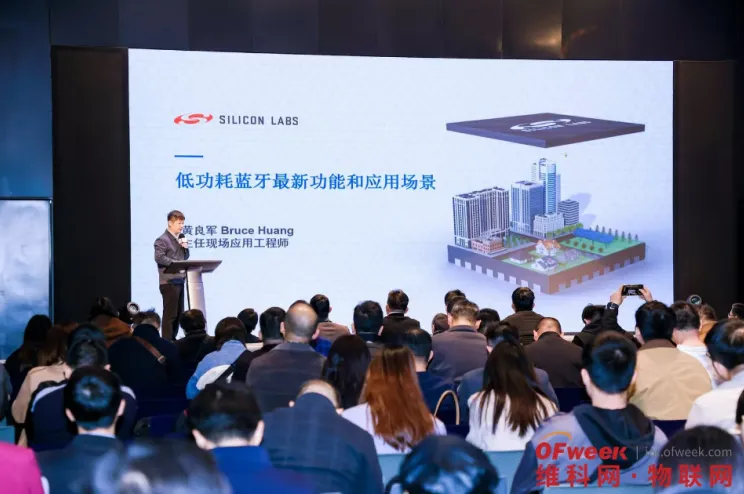
1. Deepening Foundations: Silicon Labs Closely Follows the Pulse of Technological Change
According to Huang Liangjun, for the past decade since Silicon Labs’ transformation, the company has focused on IoT wireless connection products and technologies. Today, its product matrix and technology encompass Bluetooth, Wi-Fi, Matter, Zigbee, and widely used Wi-SUN for industrial metering, among others. Relying on years of technological accumulation and R&D refinement, Silicon Labs has taken the lead in the industry by integrating multiple wireless connection protocols into a single chip.
With Bluetooth technology at its core, Silicon Labs has cleverly designed architectures and optimized algorithms, enabling the chip to simultaneously run various protocol combinations such as Zigbee and Bluetooth, Thread and Bluetooth, and Matter plus Bluetooth, greatly expanding the chip’s application scenarios and functional boundaries. This integrated design concept breaks the limitations of traditional chips that support single protocols, providing IoT device manufacturers with more convenient and efficient solutions. For example, in smart home scenarios, a smart device based on Silicon Labs’ chip can quickly connect with the user’s smartphone via Bluetooth for device control and data interaction; simultaneously, using the Thread protocol, it can form a stable local area network with other smart devices in the home, achieving interconnectivity among devices; the support for the Matter protocol ensures cross-platform compatibility and interoperability, allowing it to easily integrate into different brands’ smart home ecosystems.
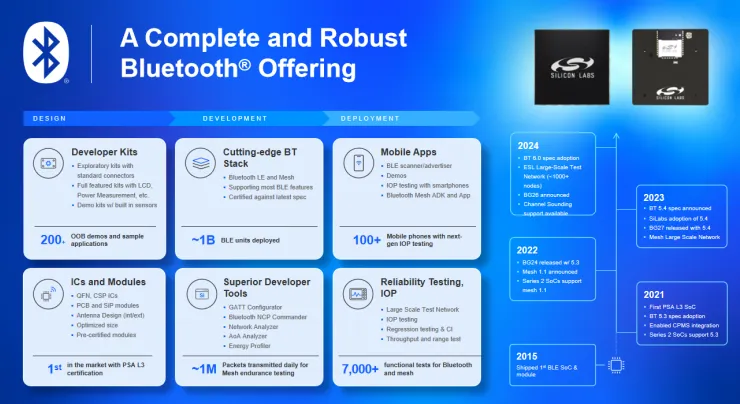
“Quality product strength + closely following the pulse of technological change is the core driving force behind Silicon Labs’ outstanding performance,” said Mr. Huang Liangjun. Since the launch of Silicon Labs’ first SOC, the company has kept pace with the latest standards of the Bluetooth Alliance, launching corresponding Profiles that seamlessly meet market demands. To date, Silicon Labs has achieved chip sales of one billion units, winning high recognition and trust from numerous partners and end users.
2. Bluetooth 5.4: Reshaping the Application Paradigm of Electronic Shelf Labels
When discussing how Silicon Labs focuses on cutting-edge Bluetooth technology, Mr. Huang Liangjun highlighted two key technological breakthroughs made by the company in Bluetooth 5.4: first, the launch of the ESL (Electronic Shelf Label) Profile and Service, which is based on a new underlying communication technology—PAwR. PAwR itself is a synchronized, time-division multiplexed Bluetooth technology that possesses powerful node communication capabilities, allowing a central node to establish stable bidirectional communication links with hundreds or even thousands of peripheral nodes. Its synchronous characteristic also effectively avoids signal conflicts and packet loss issues caused by unordered transmission from peripheral nodes, ensuring stability and reliability in data transmission.
Secondly, this technology fully considers the battery supply challenges of ESL devices, allowing peripheral nodes to enter sleep mode during non-communication periods, significantly reducing power consumption and extending the battery life of electronic shelf labels to several years, precisely meeting the urgent demand for long endurance and low power consumption in ESL applications.
Additionally, Silicon Labs has optimized the new feature of Bluetooth 5.4—broadcast data encryption—ensuring that users can effectively resist external prying and theft during bidirectional communication, safeguarding the security and confidentiality of commercial information, providing solid and reliable guarantees for information exchange in retail scenarios.
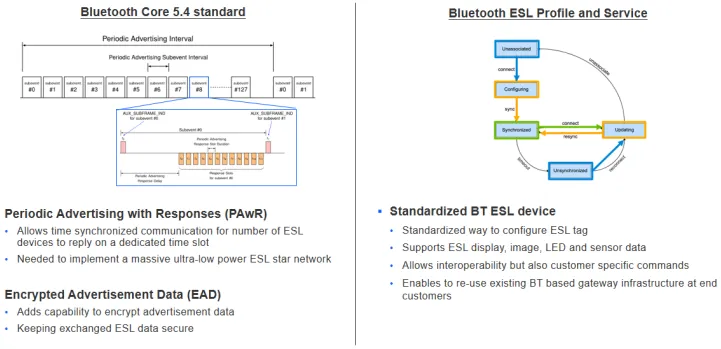
In Mr. Huang Liangjun’s view, the current electronic shelf label market contains enormous development potential, with the existing market size reaching 10 billion yuan. According to data from the Toubao Research Institute, this figure is expected to expand to 30 billion yuan by 2026; however, the actual application rate is currently less than 10%, which undoubtedly provides ample space for the entry of Bluetooth 5.4 technology.
Traditional electronic shelf labels often suffer from update delays, while the application of Bluetooth 5.4 technology ensures that product and price information can be displayed timely and accurately, significantly enhancing usability. Compared to previous interaction methods based on QR codes or NFC, the integration of Bluetooth technology makes operations more convenient and efficient. Furthermore, leveraging Bluetooth’s RSI, AOA, and AOD ranging and angle measurement technologies, electronic shelf labels can achieve precise positioning, providing strong support for optimizing retail store layouts and product management. Additionally, by integrating with weight sensors, visual sensors, and other devices, Bluetooth-based electronic shelf label systems can monitor product sales in real-time on the shelves, issuing restock reminders promptly, further enhancing the intelligence of retail operations and management efficiency.
At the product level, Silicon Labs has specially designed the BG22 chip for ESL applications. This chip stands out due to its ultra-low power characteristics, requiring only a button battery to achieve a battery life of over ten years, while also offering excellent cost-performance advantages. In addition, Silicon Labs has launched ESL gateways and reference design solutions to provide customers with a one-stop solution, effectively promoting the widespread application of Bluetooth 5.4 technology in the electronic shelf label field and accelerating the arrival of the smart retail era.
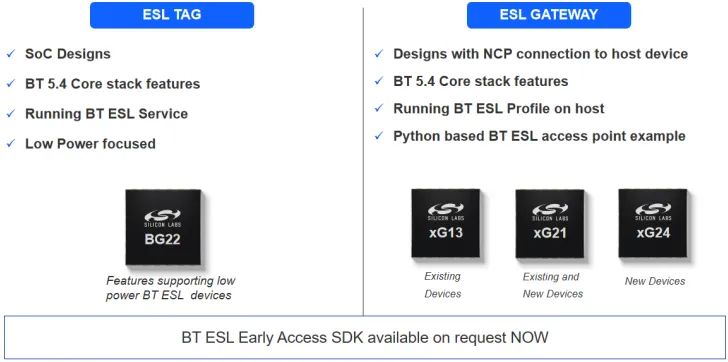
3. Silicon Labs Paints a New Picture of Smart Applications with Bluetooth 6.0 Channel Sensing
As a pioneer standing at the forefront of Bluetooth technology iteration, Silicon Labs has integrated channel sensing technology into its solution system since the Bluetooth Special Interest Group launched the latest Bluetooth 6.0 standard, leveraging its deep technical accumulation and keen market insight to actively explore the application possibilities of this technology across diverse fields.
Mr. Huang Liangjun introduced that during the R&D process, Silicon Labs built a sliding track for testing in its Finnish laboratory, continuously investing effort into testing and optimization, accumulating detailed ranging data. Thanks to Silicon Labs’ dual-antenna design and algorithm improvements, the chip’s penetration capability has significantly increased. For instance, in an office setting, with a distance of 34 meters and wooden partition walls, the accuracy can reach 0.3 meters; at 15 meters with no strong obstructions, the accuracy is 0.2 meters; even under extreme conditions with two walls as barriers, it can still maintain a reliable accuracy of 0.5 meters, laying a solid foundation for the application of channel sensing technology.
At the same time, Silicon Labs has integrated the channel sensing visualization function module into the development environment, Silicon Studio. By using a wireless development board as the initiating base station for channel sensing, combined with battery-powered wireless tags, users can intuitively see the distance change curves on Silicon Studio, providing more intuitive and accurate data feedback for technicians during debugging and optimization, further accelerating the product R&D process and application promotion.
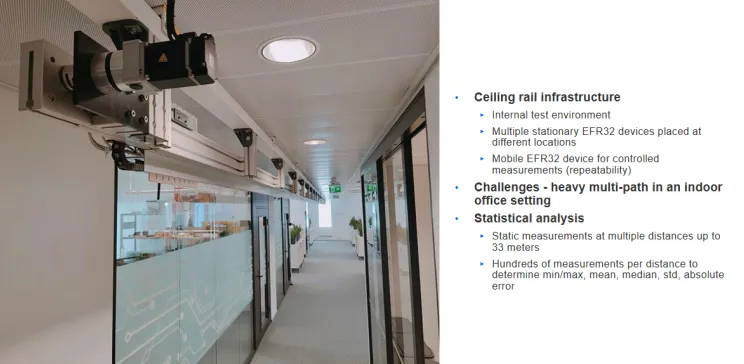
As one of the key features of Bluetooth 6.0, the core application scenarios of channel sensing technology have already become the focal point of attention for enterprises along the industrial chain. With years of in-depth experience in the field of Bluetooth technology, Mr. Huang pointed out that this technology will mainly focus on two directions: proximity sensing and precise positioning. Among them, the growth potential in proximity sensing applications is particularly evident in automotive keyless entry systems (PEPS). Although UWB technology is already applied in this field, it generally faces challenges such as high power consumption, high costs, and insufficient smartphone penetration. Channel sensing technology, with its low power consumption, high stability, and ease of deployment, is expected to become the mainstream choice for future digital car keys.
In the field of precise positioning, pet tracking has become a significant application case and market growth point. For instance, with a pet collar equipped with Bluetooth 6.0 technology, owners can easily set up electronic fences to prevent pets from entering dangerous areas. In the event of a pet going missing, channel sensing technology can also quickly locate them, enhancing the success rate of pet recovery.
Specifically, at the product level, Silicon Labs’ BG24 Bluetooth chip is equipped with channel sensing technology. According to Mr. Huang Liangjun, this Bluetooth chip has a transmission power of up to 20dBM, easily meeting user demands for long-distance communication. Additionally, the chip is equipped with AI and machine learning accelerators, providing robust computational support for subsequent algorithm optimization.
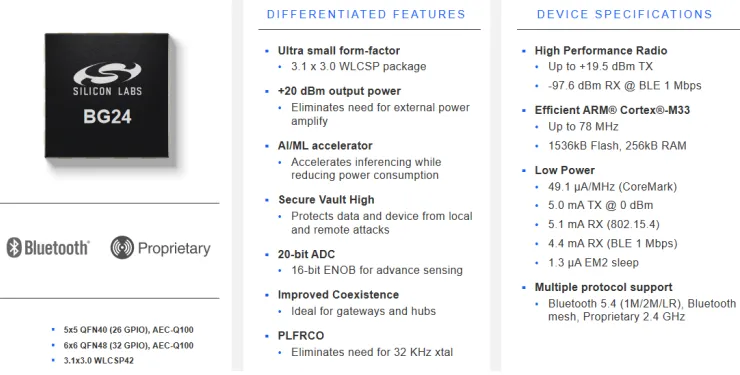
Conclusion
Silicon Labs’ continuous innovation and deep application in the low-power Bluetooth technology field inject a strong impetus into the development of the IoT industry. The innovative applications of Bluetooth 5.4 in the ESL field and the breakthroughs of Bluetooth 6.0 channel sensing technology in precise positioning not only demonstrate Silicon Labs’ technological foresight but also lay a solid foundation for the widespread application of IoT in various fields such as smart retail, smart asset management, and smart security. We have reason to believe that low-power Bluetooth technology will drive the IoT industry into a new era of “intelligent connectivity of all things”.
Article image source: Silicon Labs official